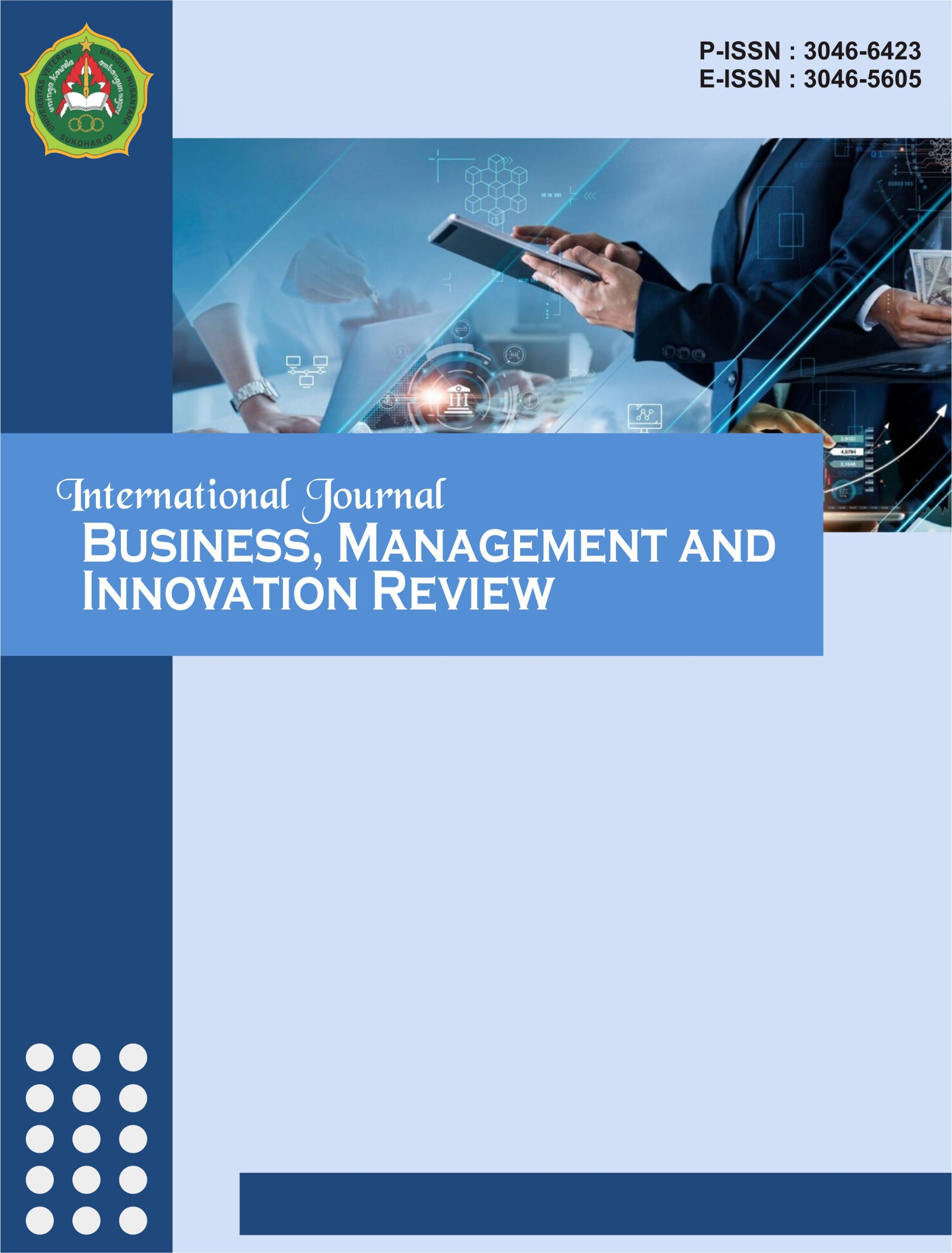Pragmatic Diversification in ASEAN: Strategic Responses to Trade War Ripple Effects in 2025
DOI:
https://doi.org/10.62951/ijbmir.v2i2.127Keywords:
ASEAN Trade Strategy, Geoeconomics, Pragmatic Diversification, Trade RealignmentAbstract
This study explores how selected ASEAN countries Vietnam, Indonesia, and Thailand strategically diversified their trade partnerships in response to the global trade war ripple effects in 2025. Amid intensifying geopolitical tension, technological decoupling, and rising non-tariff trade barriers, these countries have adopted distinct strategies: Vietnam pursues export-led realignment, Indonesia promotes resource-based sovereignty, and Thailand engages in hybrid sectoral diplomacy. Through qualitative content analysis of trade policy documents and institutional reports, the study identifies a shared pattern of reduced dependence on traditional powers while highlighting the fragmented nature of ASEAN-wide coordination. The findings offer new insights into "pragmatic diversification"—a flexible and nationally calibrated trade strategy. Although ASEAN's collective frameworks remain secondary to national priorities, the country-level strategies show promise for enhancing regional resilience. The study contributes to the literature by connecting strategic trade theory with current policy evidence, offering a forward-looking, comparative assessment of diversification under trade war disruption. It concludes with implications for regional policy coherence and institutional capacity building
References
Anuchitworawong, C. (2010). The Value of Principles-Based Governance Practices and the Attenuation of Information Asymmetry. Asia-Pacific Financial Markets, 17(2), 171–207. https://doi.org/10.1007/s10690-010-9114-4
ASEAN Secretariat. (2025). ASEAN Investment Report 2024 : ASEAN Economic Community 2025 and Foreign Direct Investment. https://asean.org/book/asean-investment-report-2024-asean-economic-community-2025-and-foreign-direct-investment/
Ba, A. (2014). Institutional divergence and convergence in the Asia-Pacific? ASEAN in practice and in theory. Cambridge Review of International Affairs, 27(2), 295–318. https://doi.org/10.1080/09557571.2014.889082
Ba, A. D. (2023). Diversification’s legitimation challenges: ASEAN and its Myanmar predicament. International Affairs, 99(3), 1063–1085. https://doi.org/10.1093/ia/iiad061
Brander, J. A., & Spencer, B. J. (1985). Export subsidies and international market share rivalry. Journal of International Economics, 18(1–2), 83–100. https://doi.org/10.1016/0022-1996(85)90006-6
Campbell, R., Goodman-Williams, R., Feeney, H., & Fehler-Cabral, G. (2018). Assessing Triangulation Across Methodologies, Methods, and Stakeholder Groups: The Joys, Woes, and Politics of Interpreting Convergent and Divergent Data. American Journal of Evaluation, 41, 125–144. https://doi.org/10.1177/1098214018804195
Cooper, A. F., & Cannon, B. J. (2024). Contested informality in regional institutional design: A comparative analysis of ASEAN and the Quad. Global Policy, 15(1), 40–52. https://doi.org/10.1111/1758-5899.13335
Corning, G. (2022). ASEAN and the Regime Complex for Digital Trade in the Asia-Pacific. Journal of World Trade. https://doi.org/10.54648/trad2022038
Dinopoulos, E., Heins, G., & Unel, B. (2024). Tariff wars, unemployment, and top incomes. Journal of Monetary Economics, 148, 103616. https://doi.org/10.1016/j.jmoneco.2024.103616
Doanh, N. K., Doan, H. Q., & Heo, Y. (2023). Impact of imitation ability on ASEAN countries’ intra-industry trade: a system GMM approach. Journal of the Asia Pacific Economy, 28(2), 692–715. https://doi.org/10.1080/13547860.2021.1892473
Evenett, S., Jakubik, A., Martín, F., & Ruta, M. (2024). The return of industrial policy in data. The World Economy, 47(7), 2762–2788. https://doi.org/10.1111/twec.13608
Freund, C., Mattoo, A., Mulabdic, A., & Ruta, M. (2024). Is US trade policy reshaping global supply chains? Journal of International Economics, 152, 104011.
Frost, E. L. (2021). The New Geopolitics of Trade and Investment in Asia: Multilateralism, Regionalism, Protectionism, or All of the Above? Asia Policy, 16(4), 23–36. https://doi.org/10.1353/asp.2021.0044
Grieco, J. M. (1990). Realism, Neoliberal Institutionalism, and the Problem of International Cooperation. In Cooperation among Nations (pp. 27–50). Cornell University Press. https://doi.org/10.7591/9781501725043-004
Haas, E. B. (2020). Uniting of Europe: Political, Social, and Economic Forces, 1950-1957. University of Notre Dame Press.
Hartig, J. H., Zarull, M. A., & Munawar, M. (2018). Preface. Aquatic Ecosystem Health & Management, 21(4), 373–377. https://doi.org/10.1080/14634988.2018.1540232
Hopewell, K. (2022). Beyond U.S.-China Rivalry: Rule Breaking, Economic Coercion, and the Weaponization of Trade. AJIL Unbound, 116, 58–63. https://doi.org/10.1017/aju.2022.3
Horner, R. (2016). A New Economic Geography of Trade and Development? Governing South–South Trade, Value Chains and Production Networks. Territory, Politics, Governance, 4(4), 400–420. https://doi.org/10.1080/21622671.2015.1073614
Horner, R., & Hulme, D. (2019). From International to Global Development: New Geographies of 21 st Century Development. Development and Change, 50(2), 347–378. https://doi.org/10.1111/dech.12379
Ju, J., Ma, H., Wang, Z., & Zhu, X. (2024). Trade wars and industrial policy competitions: Understanding the US-China economic conflicts. Journal of Monetary Economics, 141, 42–58. https://doi.org/10.1016/j.jmoneco.2023.10.012
Kleinheksel, A., Rockich-Winston, N., Tawfik, H., & Wyatt, T. (2020). Demystifying Content Analysis. American Journal of Pharmaceutical Education, 84. https://doi.org/10.5688/ajpe7113
Knobel, A. Y., Ponomareva, O. V., & Sedalishchev, V. V. (2024). Impact of Trade Wars on the Global Economy and on the Macroeconomic and Sectoral Indicators of the USA and China. Economic Policy, 19(5), 30–53. https://doi.org/10.18288/1994-5124-2024-5-30-53
Leu, G. (2011). ASEAN’s Preferential Trade Agreements (PTA) Strategy. Journal of Current Southeast Asian Affairs, 30(2), 31–64. https://doi.org/10.1177/186810341103000203
Lim, B., Hong, K., Yoon, J., Chang, J.-I., & Cheong, I. (2021). Pitfalls of the EU’s Carbon Border Adjustment Mechanism. Energies, 14(21), 7303. https://doi.org/10.3390/en14217303
Lim, S., & Nguyen, A. P. T. (2024). Shifting Trade Winds: Southeast Asia’s Response to the United States–People’s Republic of China Trade Dispute. Asian Development Review. https://doi.org/10.1142/s0116110524400134
Ma, H., & Ning, J. (2024). The return of protectionism: Prospects for Sino-US trade relations in the wake of the trade war. China Economic Quarterly International, 4(3), 182–211. https://doi.org/10.1016/j.ceqi.2024.09.003
Ma, X., Ma, L., Arshad, R., & Alofaysan, H. (2024). Sustainable development in ASEAN : The role of trade diversification, government revenue, and natural resources. Natural Resources Forum. https://doi.org/10.1111/1477-8947.12526
Panao, R. (2024). Winning hearts in Southeast Asia? News sentiment on China amidst the US–PRC trade war. Asian Journal of Comparative Politics. https://doi.org/10.1177/20578911241252692
Petri, P. A., & Plummer, M. G. (2020). East Asia Decouples from the United States: Trade War, COVID-19, and East Asia’s New Trade Blocs. SSRN Electronic Journal. https://doi.org/10.2139/ssrn.3630294
Ramadhan, I. (2022). ASEAN Consensus and Forming Cybersecurity Regulation in Southeast Asia. Proceedings of the 1st International Conference on Contemporary Risk Studies, ICONIC-RS 2022, 31 March-1 April 2022, South Jakarta, DKI Jakarta, Indonesia. https://doi.org/10.4108/eai.31-3-2022.2320684
Shimizu, K. (2021). The ASEAN Economic Community and the RCEP in the world economy. Journal of Contemporary East Asia Studies, 10(1), 1–23. https://doi.org/10.1080/24761028.2021.1907881
Siregar, Y. I. (2024). Pathways towards net-zero emissions in Indonesia’s energy sector. Energy, 308, 133014. https://doi.org/10.1016/j.energy.2024.133014
Sun, X., Mi, Z., Cheng, L., Coffman, D., & Liu, Y. (2024). The carbon border adjustment mechanism is inefficient in addressing carbon leakage and results in unfair welfare losses. Fundamental Research, 4(3), 660–670. https://doi.org/10.1016/j.fmre.2023.02.026
Sundram, P. (2023). ASEAN as network governance: An alternative lens to evaluate policymaking and performance. F1000Research, 12, 1073. https://doi.org/10.12688/f1000research.136338.2
Sundram, P. (2024). ASEAN cooperation to combat transnational crime: progress, perils, and prospects. Frontiers in Political Science. https://doi.org/10.3389/fpos.2024.1304828
Tan, S. S. (2020). Consigned to hedge: Southeast Asia and America’s ‘free and open Indo-Pacific’ strategy. International Affairs, 96, 131–148. https://doi.org/10.1093/ia/iiz227
Trilling, D., & Jonkman, J. (2018). Scaling up Content Analysis. Communication Methods and Measures, 12, 158–174. https://doi.org/10.1080/19312458.2018.1447655
Xu, Y., Jia, F., Wang, L., & Chen, L. (2024). Can digital transformation improve firm resilience to supply chain disruption? The role of diversification strategies. Journal of Purchasing and Supply Management, 30(5), 100952. https://doi.org/10.1016/j.pursup.2024.100952
Downloads
Published
How to Cite
Issue
Section
License
Copyright (c) 2025 International Journal Business, Management and Innovation Review

This work is licensed under a Creative Commons Attribution-ShareAlike 4.0 International License.









